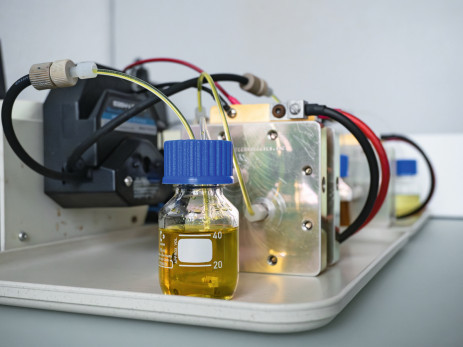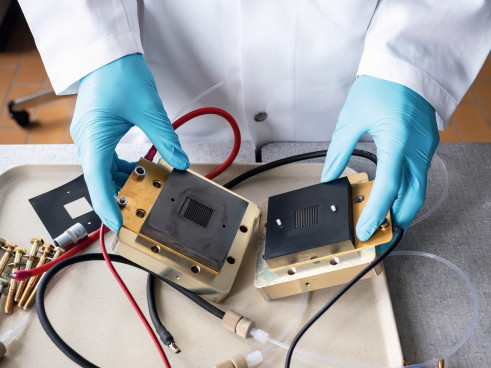... and safe, one could add, because unlike lithium-ion batteries, it is incombustible. Empa is working on the redox flow battery.
Two colored liquids bubbling through tubes: is this what the battery of the future will look like? Empa researcher David Reber wants to answer this question over the next four years with the support of an "Ambizione" grant from the Swiss National Science Foundation (SNSF). So-called redox flow batteries have been known since the 1970s. In contrast to conventional lithium-ion batteries, they do not store energy in solid electrodes, but in tanks with liquid electrolyte solutions. The charging and discharging process does not take place in the tanks themselves: Instead, the electrolytes are
The electrolytes are pumped through an electrochemical cell. This type of battery is particularly suitable as a large unit for use in urban areas
This type of battery is particularly suitable as a large unit for use in urban areas
Unsuitable for small devices
Liquid batteries are impractical for cell phones, laptops or cars. However, they are very promising for stationary storage solutions. As the energy is stored outside the actual cell, flow batteries can be scaled particularly easily and specifically. If the battery needs to charge and discharge faster, a larger electrochemical cell is required. If it is to have a larger storage capacity, larger tanks are needed. "With the increasing use of renewable energies, we will need energy storage systems on a large scale - even in urban areas," says Reber. Another plus point for flow batteries: If water-based electrolytes are used, they are fundamentally non-flammable, unlike conventional lithium-ion batteries. Nevertheless, the technology has not yet caught on. Reber is aware of the main problem: "Flow batteries have an energy density around ten times lower than batteries made from solid storage materials," he explains. The more storage material can be dissolved in the electrolyte, the higher the energy density of a flow battery. "However, high concentrations make the solution viscous and you need a lot more energy to pump it through the cell," says the researcher. It is precisely this problem that Reber now wants to solve in his work in Empa's "Materials for Energy Conversion" laboratory - with an unusual approach. While most projects on flow batteries focus on more soluble storage materials, he wants to completely decouple energy storage from the electrolyte solution. "My vision is to develop a kind of hybrid of a flow battery and a lithium-ion battery," says the researcher. To achieve this, he wants to add solid storage materials, such as those used in cell phone batteries, to the tank of the flow battery. "If the dissolved material and the solid storage material are precisely matched, they can transfer energy to each other," explains Reber. "This allows the scalability of flow batteries to be combined with the high energy density of batteries with solid storage materials." Flow batteries decouple the charging process from the storage. This has a positive effect on scalability
Flow batteries decouple the charging process from the storage. This has a positive effect on scalability
Materials sought
First, however, the researcher has to find suitable pairs of materials that enable energy exchange and remain stable over a longer period of time. "Ideally, a redox flow battery should be able to be operated for around 20 years," he says. Whether a material pair fits together depends on the so-called redox potential of the materials: the voltage at which they release or accept electrons. "I already have a few possible pairs in mind," says Reber. And if a promising pair does not match exactly, its redox potentials can be manipulated with certain chemical manipulations.one of Reber's ideas is to use a chelate as a dissolved storage material: a multi-armed organic molecule that "wraps itself" around a metal ion. The redox potential changes depending on how many arms the organic molecule - the ligand - has. Reber already researched chelate-based redox flow batteries during his postdoc at the University of Colorado (Boulder), for which he will receive the prestigious "Battery Division Postdoc Award" at the annual meeting of the Electrochemical Society in Gothenburg in October. At the end of his "Ambizione" funding period of four years, Reber hopes to have a well-functioning battery with an additional permanent storage unit. "If this approach works, the possible applications are very diverse," he says. For example, compact flow batteries with a flexible form factor could be much easier to integrate in urban areas. "All it would take is pumps and a few hoses," adds the researcher.


